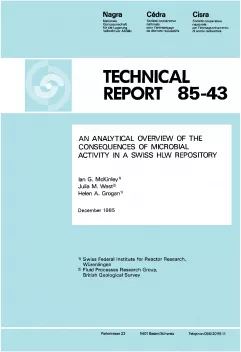
Technical Report NTB 85-43
An analytical overview of the consequences of microbial activity in a Swiss HLW repository
Microorganisms are known to be important factors in many geochemical processes and their presence can be assured throughout the envisaged Swiss type C repository for HLW. It is likely that both introduced and resident microbes will colonise the near-field even at times when ambient temperature and radiation fields are relatively high. A simple quantitative model has been developed which indicates that microbial growth in the near-field is limited by the rate of supply of chemical energy from corrosion of the canister.
Microbial processes examined include biodegradation of structural and packaging materials, alteration of groundwater chemistry (Eh, pH, organic complexant concentration) and direct nuclide uptake by microorganisms. The most important effects of such organisms are likely to be enhancement of release and mobility of key nuclides due to their complexation by microbial by-products. Resident micro-organisms in the far-field could potentially act as 'living colloids' thus enhancing nuclide transport. In the case of flow paths through shear zones (kakirites), however, any microbes capable of penetrating the surrounding weathered rock matrix would be extensively retarded.
Although many gaps exist in the understanding of relevant geomicrobiological processes, research priorities can be assigned by considering the applicability of data produced to repository safety assessment. It is concluded that microbial processes are unlikely to be of significance for HLW but will be more important for low / intermediate waste types. As data requirements are similar for all waste types, results from such studies would also resolve the main uncertainties remaining for the HLW case. Key research areas are identified as characterisation of a) nutrient availability in the near-field, b) the bioenergetics of iron corrosion, c) production of organic by-products, d) nuclide sorption by organisms and e) microbial mobility in the near- and far-field.
Site specific studies are recommended but sampling must be coupled to evaluation of the tolerance of important microbial groups to expected repository conditions. All this work must be carefully coordinated in an integral research programme as many of the important processes involved are interrelated.
